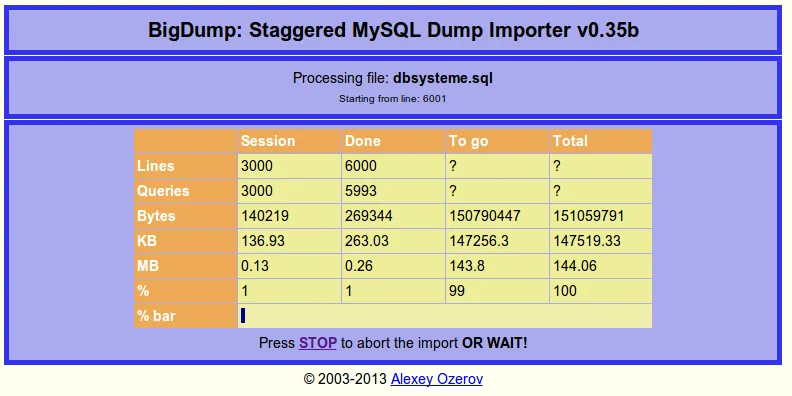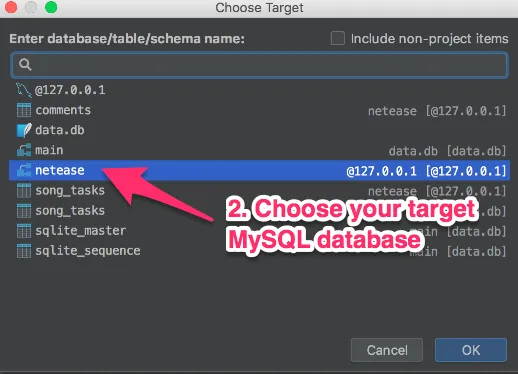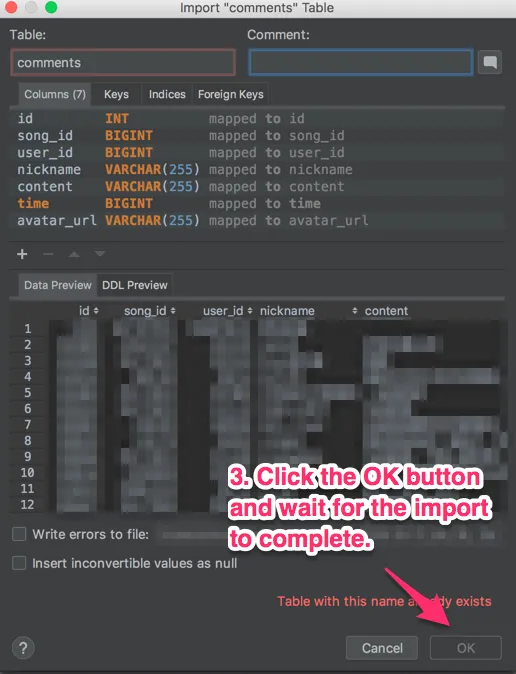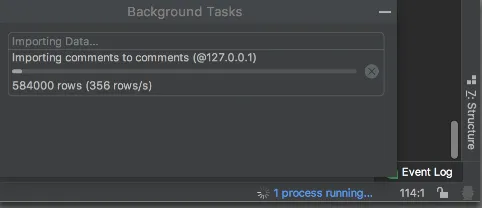有人知道将SQLite3数据库迁移到MySQL的快速简便方法吗?
以下是我知道在这两种文件格式之间SQL语法的所有差异列表: 以以下内容开头的行:
BEGIN TRANSACTION COMMIT sqlite_sequence CREATE UNIQUE INDEX
在MySQL中不使用。
SQLite使用CREATE TABLE/INSERT INTO "table_name",而MySQL使用CREATE TABLE/INSERT INTO table_name。 MySQL不在模式定义内使用引号。 MySQL在INSERT INTO子句中使用单引号表示字符串。 SQLite和MySQL有不同的方法来转义INSERT INTO子句中的字符串。 SQLite使用't'和'f'表示布尔值,而MySQL使用1和0(当您在INSERT INTO中有像"I do, you don't"这样的字符串时,简单的正则表达式可能会失败)。 SQLLite使用AUTOINCREMENT,MySQL使用AUTO_INCREMENT。
这是一个非常基本的perl脚本,可适用于我的数据集,并检查其他我在网上找到的perl脚本中的更多条件。不能保证它适用于您的数据,但请随意修改并在此处发布。
#! /usr/bin/perl
while ($line = <>){
if (($line !~ /BEGIN TRANSACTION/) && ($line !~ /COMMIT/) && ($line !~ /sqlite_sequence/) && ($line !~ /CREATE UNIQUE INDEX/)){
if ($line =~ /CREATE TABLE \"([a-z_]*)\"(.*)/i){
$name = $1;
$sub = $2;
$sub =~ s/\"//g;
$line = "DROP TABLE IF EXISTS $name;\nCREATE TABLE IF NOT EXISTS $name$sub\n";
}
elsif ($line =~ /INSERT INTO \"([a-z_]*)\"(.*)/i){
$line = "INSERT INTO $1$2\n";
$line =~ s/\"/\\\"/g;
$line =~ s/\"/\'/g;
}else{
$line =~ s/\'\'/\\\'/g;
}
$line =~ s/([^\\'])\'t\'(.)/$1THIS_IS_TRUE$2/g;
$line =~ s/THIS_IS_TRUE/1/g;
$line =~ s/([^\\'])\'f\'(.)/$1THIS_IS_FALSE$2/g;
$line =~ s/THIS_IS_FALSE/0/g;
$line =~ s/AUTOINCREMENT/AUTO_INCREMENT/g;
print $line;
}
}
9
这里是一份转换器列表(自2011年以来未更新):
一个很少被提及但很好用的替代方法是:使用ORM类来抽象特定数据库差异。例如,在PHP中你可以使用RedBean,在Python中你可以使用Django的ORM层、Storm和SqlAlchemy,在Ruby on Rails中你可以使用ActiveRecord,在Cocoa中你可以使用CoreData。
也就是说,你可以这样做:
- 使用ORM类从源数据库加载数据。
- 将数据存储在内存中或序列化到磁盘中。
- 使用ORM类将数据存储到目标数据库中。
3
我把它变成了社区wiki,所以请随意编辑和重构,只要不破坏功能(谢天谢地我们可以回滚) - 它看起来很丑但是可用。
使用方法如下(假设脚本名为
dump_for_mysql.py):sqlite3 sample.db .dump | python dump_for_mysql.py > dump.sql
然后您可以将其导入MySQL中
注意 - 您需要手动添加外键约束,因为SQLite实际上不支持它们
这是脚本:
#!/usr/bin/env python
import re
import fileinput
def this_line_is_useless(line):
useless_es = [
'BEGIN TRANSACTION',
'COMMIT',
'sqlite_sequence',
'CREATE UNIQUE INDEX',
'PRAGMA foreign_keys=OFF',
]
for useless in useless_es:
if re.search(useless, line):
return True
def has_primary_key(line):
return bool(re.search(r'PRIMARY KEY', line))
searching_for_end = False
for line in fileinput.input():
if this_line_is_useless(line):
continue
# this line was necessary because '');
# would be converted to \'); which isn't appropriate
if re.match(r".*, ''\);", line):
line = re.sub(r"''\);", r'``);', line)
if re.match(r'^CREATE TABLE.*', line):
searching_for_end = True
m = re.search('CREATE TABLE "?(\w*)"?(.*)', line)
if m:
name, sub = m.groups()
line = "DROP TABLE IF EXISTS %(name)s;\nCREATE TABLE IF NOT EXISTS `%(name)s`%(sub)s\n"
line = line % dict(name=name, sub=sub)
else:
m = re.search('INSERT INTO "(\w*)"(.*)', line)
if m:
line = 'INSERT INTO %s%s\n' % m.groups()
line = line.replace('"', r'\"')
line = line.replace('"', "'")
line = re.sub(r"([^'])'t'(.)", "\1THIS_IS_TRUE\2", line)
line = line.replace('THIS_IS_TRUE', '1')
line = re.sub(r"([^'])'f'(.)", "\1THIS_IS_FALSE\2", line)
line = line.replace('THIS_IS_FALSE', '0')
# Add auto_increment if it is not there since sqlite auto_increments ALL
# primary keys
if searching_for_end:
if re.search(r"integer(?:\s+\w+)*\s*PRIMARY KEY(?:\s+\w+)*\s*,", line):
line = line.replace("PRIMARY KEY", "PRIMARY KEY AUTO_INCREMENT")
# replace " and ' with ` because mysql doesn't like quotes in CREATE commands
if line.find('DEFAULT') == -1:
line = line.replace(r'"', r'`').replace(r"'", r'`')
else:
parts = line.split('DEFAULT')
parts[0] = parts[0].replace(r'"', r'`').replace(r"'", r'`')
line = 'DEFAULT'.join(parts)
# And now we convert it back (see above)
if re.match(r".*, ``\);", line):
line = re.sub(r'``\);', r"'');", line)
if searching_for_end and re.match(r'.*\);', line):
searching_for_end = False
if re.match(r"CREATE INDEX", line):
line = re.sub('"', '`', line)
if re.match(r"AUTOINCREMENT", line):
line = re.sub("AUTOINCREMENT", "AUTO_INCREMENT", line)
print line,
9
schema_migrations (version varchar(255) NOT NULL);
INSERT INTO schema_migrations VALUES(20100714032840);
INSERT INTO schema_migrations VALUES('20100714033251');
__ - DavidBlobvar 数据类型,在 CREATE 语句中使用反引号... - Frank Hintsch如果您正在使用Python/Django,这将非常容易:
在settings.py中创建两个数据库(像这里https://docs.djangoproject.com/en/1.11/topics/db/multi-db/)
然后只需像这样操作:
objlist = ModelObject.objects.using('sqlite').all()
for obj in objlist:
obj.save(using='mysql')
1
import django
django.setup()
from .models import ModelObject - borko最快最简单的方式可能是使用sqlite的.dump命令,在这种情况下创建样本数据库的转储。
sqlite3 sample.db .dump > dump.sql
理论上,您可以将此文件导入到MySQL数据库中,本例中使用的是位于数据库服务器127.0.0.1上的测试数据库,并使用用户名root。
mysql -p -u root -h 127.0.0.1 test < dump.sql
我说“理论上”因为语法之间存在一些差异。
在SQLite中,事务开始于
BEGIN TRANSACTION;
...
COMMIT;
BEGIN;
...
COMMIT;
还有其他类似的问题(比如变量和双引号),但使用“查找和替换”功能就能解决。
也许你应该问一下自己为什么要进行迁移。如果性能/数据库大小是问题所在,也许可以考虑重新组织架构;如果系统正在升级到更强大的产品,那么现在正是规划数据未来的理想时机。
1
我刚刚经历了这个过程,在这个问答中有很多非常好的帮助和信息,但我发现我必须整合各种元素(加上其他问答中的一些元素)才能成功迁移。
然而,即使组合了现有的答案,我发现Python脚本对于在INSERT中有多个布尔值出现的情况并没有完全起作用。请参见这里为什么会这样。
所以,我想在这里发布我的合并答案。 当然,功劳归于其他贡献者。 但我想回馈一些东西,并节省其他人的时间。
我将在下面发布脚本。 但首先,以下是转换说明...
我在OS X 10.7.5 Lion上运行了该脚本。 Python可以直接使用。
要从现有的SQLite3数据库生成MySQL输入文件,请按以下方式运行脚本:
Snips$ sqlite3 original_database.sqlite3 .dump | python ~/scripts/dump_for_mysql.py > dumped_data.sql
然后我将生成的dumped_sql.sql文件复制到运行Ubuntu 10.04.4 LTS的Linux机器上,我的MySQL数据库就在那里。
导入MySQL文件时,我遇到的另一个问题是,一些unicode UTF-8字符(特别是单引号)没有被正确导入,所以我必须添加一个开关到命令中来指定UTF-8。
将数据输入全新的空MySQL数据库的结果命令如下:
Snips$ mysql -p -u root -h 127.0.0.1 test_import --default-character-set=utf8 < dumped_data.sql
让它煮一会儿,就可以了!在迁移前后,不要忘记仔细审查您的数据。
所以,正如OP所请求的那样,当您知道如何操作时,这很快也很容易! :-)
顺便说一下,在我调查这个迁移之前,我不确定created_at和updated_at字段值是否会被保留 - 对我来说好消息是它们会被保留,所以我可以迁移我的现有生产数据。
祝你好运!
更新:
自从进行了这个转换后,我注意到了一个之前没有注意到的问题。在我的Rails应用程序中,我的文本字段被定义为“string”,并且这一点体现在数据库模式中。这里概述的过程会导致这些字段在MySQL数据库中被定义为VARCHAR(255)。这对这些字段大小施加了255个字符的限制 - 超出这个限制的任何内容都将在导入过程中被默默截断。为了支持大于255的文本长度,MySQL模式需要使用“TEXT”而不是VARCHAR(255),我认为。这里定义的过程不包括此转换。
以下是已合并和修订的Python脚本,适用于我的数据:
#!/usr/bin/env python
import re
import fileinput
def this_line_is_useless(line):
useless_es = [
'BEGIN TRANSACTION',
'COMMIT',
'sqlite_sequence',
'CREATE UNIQUE INDEX',
'PRAGMA foreign_keys=OFF'
]
for useless in useless_es:
if re.search(useless, line):
return True
def has_primary_key(line):
return bool(re.search(r'PRIMARY KEY', line))
searching_for_end = False
for line in fileinput.input():
if this_line_is_useless(line): continue
# this line was necessary because ''); was getting
# converted (inappropriately) to \');
if re.match(r".*, ''\);", line):
line = re.sub(r"''\);", r'``);', line)
if re.match(r'^CREATE TABLE.*', line):
searching_for_end = True
m = re.search('CREATE TABLE "?([A-Za-z_]*)"?(.*)', line)
if m:
name, sub = m.groups()
line = "DROP TABLE IF EXISTS %(name)s;\nCREATE TABLE IF NOT EXISTS `%(name)s`%(sub)s\n"
line = line % dict(name=name, sub=sub)
line = line.replace('AUTOINCREMENT','AUTO_INCREMENT')
line = line.replace('UNIQUE','')
line = line.replace('"','')
else:
m = re.search('INSERT INTO "([A-Za-z_]*)"(.*)', line)
if m:
line = 'INSERT INTO %s%s\n' % m.groups()
line = line.replace('"', r'\"')
line = line.replace('"', "'")
line = re.sub(r"(?<!')'t'(?=.)", r"1", line)
line = re.sub(r"(?<!')'f'(?=.)", r"0", line)
# Add auto_increment if it's not there since sqlite auto_increments ALL
# primary keys
if searching_for_end:
if re.search(r"integer(?:\s+\w+)*\s*PRIMARY KEY(?:\s+\w+)*\s*,", line):
line = line.replace("PRIMARY KEY", "PRIMARY KEY AUTO_INCREMENT")
# replace " and ' with ` because mysql doesn't like quotes in CREATE commands
# And now we convert it back (see above)
if re.match(r".*, ``\);", line):
line = re.sub(r'``\);', r"'');", line)
if searching_for_end and re.match(r'.*\);', line):
searching_for_end = False
if re.match(r"CREATE INDEX", line):
line = re.sub('"', '`', line)
print line,
1
aptitude install sqlfairy libdbd-sqlite3-perl
sqlt -f DBI --dsn dbi:SQLite:../.open-tran/ten-sq.db -t MySQL --add-drop-table > mysql-ten-sq.sql
sqlt -f DBI --dsn dbi:SQLite:../.open-tran/ten-sq.db -t Dumper --use-same-auth > sqlite2mysql-dumper.pl
chmod +x sqlite2mysql-dumper.pl
./sqlite2mysql-dumper.pl --help
./sqlite2mysql-dumper.pl --add-truncate --mysql-loadfile > mysql-dump.sql
sed -e 's/LOAD DATA INFILE/LOAD DATA LOCAL INFILE/' -i mysql-dump.sql
echo 'drop database `ten-sq`' | mysql -p -u root
echo 'create database `ten-sq` charset utf8' | mysql -p -u root
mysql -p -u root -D ten-sq < mysql-ten-sq.sql
mysql -p -u root -D ten-sq < mysql-dump.sql
int(11),并将字符串导入为varchar(300),但可以在构造函数或脚本参数中进行相应调整。注意:需要MySQL Connector/Python 2.0.4或更高版本。
如果您发现以下代码难以阅读,这里是GitHub上源代码的链接:https://github.com/techouse/sqlite3-to-mysql。
#!/usr/bin/env python3
__author__ = "Klemen Tušar"
__email__ = "techouse@gmail.com"
__copyright__ = "GPL"
__version__ = "1.0.1"
__date__ = "2015-09-12"
__status__ = "Production"
import os.path, sqlite3, mysql.connector
from mysql.connector import errorcode
class SQLite3toMySQL:
"""
Use this class to transfer an SQLite 3 database to MySQL.
NOTE: Requires MySQL Connector/Python 2.0.4 or higher (https://dev.mysql.com/downloads/connector/python/)
"""
def __init__(self, **kwargs):
self._properties = kwargs
self._sqlite_file = self._properties.get('sqlite_file', None)
if not os.path.isfile(self._sqlite_file):
print('SQLite file does not exist!')
exit(1)
self._mysql_user = self._properties.get('mysql_user', None)
if self._mysql_user is None:
print('Please provide a MySQL user!')
exit(1)
self._mysql_password = self._properties.get('mysql_password', None)
if self._mysql_password is None:
print('Please provide a MySQL password')
exit(1)
self._mysql_database = self._properties.get('mysql_database', 'transfer')
self._mysql_host = self._properties.get('mysql_host', 'localhost')
self._mysql_integer_type = self._properties.get('mysql_integer_type', 'int(11)')
self._mysql_string_type = self._properties.get('mysql_string_type', 'varchar(300)')
self._sqlite = sqlite3.connect(self._sqlite_file)
self._sqlite.row_factory = sqlite3.Row
self._sqlite_cur = self._sqlite.cursor()
self._mysql = mysql.connector.connect(
user=self._mysql_user,
password=self._mysql_password,
host=self._mysql_host
)
self._mysql_cur = self._mysql.cursor(prepared=True)
try:
self._mysql.database = self._mysql_database
except mysql.connector.Error as err:
if err.errno == errorcode.ER_BAD_DB_ERROR:
self._create_database()
else:
print(err)
exit(1)
def _create_database(self):
try:
self._mysql_cur.execute("CREATE DATABASE IF NOT EXISTS `{}` DEFAULT CHARACTER SET 'utf8'".format(self._mysql_database))
self._mysql_cur.close()
self._mysql.commit()
self._mysql.database = self._mysql_database
self._mysql_cur = self._mysql.cursor(prepared=True)
except mysql.connector.Error as err:
print('_create_database failed creating databse {}: {}'.format(self._mysql_database, err))
exit(1)
def _create_table(self, table_name):
primary_key = ''
sql = 'CREATE TABLE IF NOT EXISTS `{}` ( '.format(table_name)
self._sqlite_cur.execute('PRAGMA table_info("{}")'.format(table_name))
for row in self._sqlite_cur.fetchall():
column = dict(row)
sql += ' `{name}` {type} {notnull} {auto_increment}, '.format(
name=column['name'],
type=self._mysql_string_type if column['type'].upper() == 'TEXT' else self._mysql_integer_type,
notnull='NOT NULL' if column['notnull'] else 'NULL',
auto_increment='AUTO_INCREMENT' if column['pk'] else ''
)
if column['pk']:
primary_key = column['name']
sql += ' PRIMARY KEY (`{}`) ) ENGINE = InnoDB CHARACTER SET utf8'.format(primary_key)
try:
self._mysql_cur.execute(sql)
self._mysql.commit()
except mysql.connector.Error as err:
print('_create_table failed creating table {}: {}'.format(table_name, err))
exit(1)
def transfer(self):
self._sqlite_cur.execute("SELECT name FROM sqlite_master WHERE type='table' AND name NOT LIKE 'sqlite_%'")
for row in self._sqlite_cur.fetchall():
table = dict(row)
# create the table
self._create_table(table['name'])
# populate it
print('Transferring table {}'.format(table['name']))
self._sqlite_cur.execute('SELECT * FROM "{}"'.format(table['name']))
columns = [column[0] for column in self._sqlite_cur.description]
try:
self._mysql_cur.executemany("INSERT IGNORE INTO `{table}` ({fields}) VALUES ({placeholders})".format(
table=table['name'],
fields=('`{}`, ' * len(columns)).rstrip(' ,').format(*columns),
placeholders=('%s, ' * len(columns)).rstrip(' ,')
), (tuple(data) for data in self._sqlite_cur.fetchall()))
self._mysql.commit()
except mysql.connector.Error as err:
print('_insert_table_data failed inserting data into table {}: {}'.format(table['name'], err))
exit(1)
print('Done!')
def main():
""" For use in standalone terminal form """
import sys, argparse
parser = argparse.ArgumentParser()
parser.add_argument('--sqlite-file', dest='sqlite_file', default=None, help='SQLite3 db file')
parser.add_argument('--mysql-user', dest='mysql_user', default=None, help='MySQL user')
parser.add_argument('--mysql-password', dest='mysql_password', default=None, help='MySQL password')
parser.add_argument('--mysql-database', dest='mysql_database', default=None, help='MySQL host')
parser.add_argument('--mysql-host', dest='mysql_host', default='localhost', help='MySQL host')
parser.add_argument('--mysql-integer-type', dest='mysql_integer_type', default='int(11)', help='MySQL default integer field type')
parser.add_argument('--mysql-string-type', dest='mysql_string_type', default='varchar(300)', help='MySQL default string field type')
args = parser.parse_args()
if len(sys.argv) == 1:
parser.print_help()
exit(1)
converter = SQLite3toMySQL(
sqlite_file=args.sqlite_file,
mysql_user=args.mysql_user,
mysql_password=args.mysql_password,
mysql_database=args.mysql_database,
mysql_host=args.mysql_host,
mysql_integer_type=args.mysql_integer_type,
mysql_string_type=args.mysql_string_type
)
converter.transfer()
if __name__ == '__main__':
main()
2
获取SQL转储
moose@pc08$ sqlite3 mySqliteDatabase.db .dump > myTemporarySQLFile.sql
将导出文件导入MySQL
对于小型导入:
moose@pc08$ mysql -u <username> -p
Enter password:
....
mysql> use somedb;
Database changed
mysql> source myTemporarySQLFile.sql;
或者
mysql -u root -p somedb < myTemporarySQLFile.sql
这将提示您输入密码。请注意:如果要直接输入密码,则必须在-p后紧接着输入,不能有空格:
mysql -u root -pYOURPASS somedb < myTemporarySQLFile.sql
对于较大的数据转储:
使用mysqlimport或其他导入工具,例如BigDump。
BigDump可以为您提供进度条:

1
原文链接



 ]
]
- 在
- 表名匹配的正则表达式会漏掉数字,因此应将
希望这可以帮助未来的读者。 - Michał Leon&& ($line !~ /CREATE UNIQUE INDEX/)后添加&& ($line !~ /PRAGMA foreign_keys=OFF/)$line =~ /INSERT INTO \"([a-z_]*)\"(.*)/改为$line =~ /INSERT INTO \"([a-z_1-9]*)\"(.*)/ERROR 1064 (42000):您的SQL语法有误;请检查与您的MariaDB服务器版本相对应的手册以获取正确的语法,在第6行附近使用'FFT,Comment TEXT,FOREIGN KEY(SerialNumberRecordID)REFERENCES SerialNumTable'。我使用.\script.pl foo.sql > out.sql作为它的用法? - Jon Weinraub